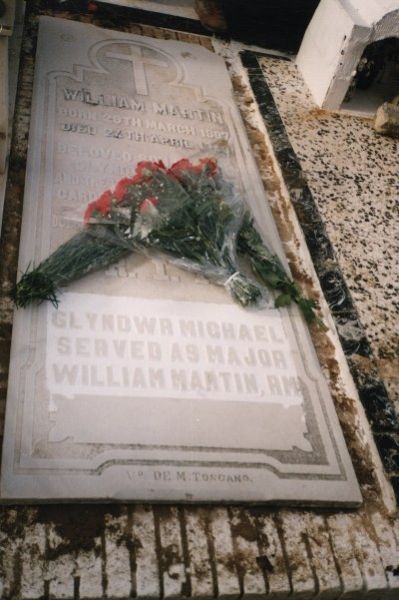Operation Mincemeat
On the cemetery in Huelva, a village on the south coast of Spain, ŕ major of the Royal Marines, William Martin lies buried since the end of April 1943. There have never been more than five people in the world who have known for sure who this man had really been.
In the fall of 1942, the Allied operations in North-Africa clearly led to victory and it was a logical conclusion that the Allied forces would subsequently launch an attack on mainland Europe. The most obvious plan was to cross from North-Africa to Sicily and make the jump to Italy.
In the opinion of the British Secret Service, the German high command had to be assured in some way or other that the expected main attack by the Allies would not be launched at Sicily but at Greece and Sardinia. To this end, a small team of British intelligence officers was formed at the end of 1942 that would tackle this problem and the inherent solutions. The intentional leaking of other plans of attack would probably not fool the Germans but when secret documents would "accidently" fall in German hands without the British knowing about it which, or so the Germans would think, just might mislead them.
The British intelligence officers arrived at the conclusion that the Germans might well be convinced when a dead officer would pass spectacular documents on to them containing other plans of attack than Sicily. If this plan was to succeed though, it would be paramount the British should eventually be able to ask the documents to be returned to them without having to know the Germans had laid their eyes on them. So, the plan to use a corpse for this operation was born but at the same time huge problems arose. It was of course possible to drop a corpse on a torn parachute over enemy territory but a post mortem by the Germans would soon reveal that the man had not died as a result of a failing parachute. Moreover, the Germans would know that the British were aware their secret plans had fallen into German hands and consequently the whole operation would fail. No, in order for this plan to succeed, another, well thought of scenario had to be found.
Continuing this train of thought of a dead courier, the British finally got the idea to have a corpse wash ashore. Since the Germans knew about British officers flying regularly between England and North-Africa, this then should be an officer carrying important documents whose aircraft had been shot down during such a flight. Subsequently he would have managed to save himself in his rubber dinghy but eventually he would have drowned in the rough sea and his body, having floated around for some time would be washed ashore somewhere in enemy territory. Immediately, a practical but serious problem arose: a dead person does not breathe so when a corpse is submerged in water for any length of time, the lungs remain empty. A post mortem by the Germans would reveal that the person had been dead before entering the water and so the bubble would burst. The next step in this ruse was the macabre search for the corpse of a relatively young man with as few friends and relatives as possible to avoid delicate questions. Early November 1942, a man was eventually found who had died of pneumonia, an affection which leaves a little fluid in the lungs after death. The man had a few relatives but permission was given to use his remains provided his identity would never be disclosed, (unfortunately, this promise would be broken years later). From that moment on the man was renamed Major of the Royal Marines William Martin and his body was stored in a refrigerator in a cylinder filled with dry ice - dry ice evaporates to carbon dioxide which replaces the oxygen so deep freezing is not necessary – while a completely new life was being made up for him. The plan was soon approved and was given the code name Mincemeat.
William Martin became a promising, albeit a little shy officer with only a few friends, serving at vice-Admiral Mountbatten’s headquarters. As he was an expert in the field of landing craft he was dispatched to North-Africa from Great Britain in order to discuss the plans for the coming landings with General Alexander. For this mission, Major Martin was given a number of very important and confidential documents, including various letters to Admiral Cunningham, General Nye and other commanders in North-Africa, naming two false targets: one in Greece and the other somewhere in the western Mediterranean and a general overview of the invasion of mainland Europe. It was also decided to give Major Martin a personal letter by Lord Louis Mountbatten to Admiral Sir Andrew Cunningham, Commander-in-Chief Mediterranean; it explained Martin’s mission and ended with: "I presume Martin is the man you are looking for. Please send him back as soon as the invasion is over; he might bring back some sardines – those are on ration here." It was thought the rusty joke about sardines would go well with the Germans and focus the attention on Sardinia as a possible target. All told, Major Martin was a rich source of information for any good intelligence service.
Major Martin’s private life was also well thought of and therefore he had two love letters in his wallet from a girl he had met before he left for North-Africa. They had been folded and unfolded countless times to make them look real. In addition he carried a letter from his bank, urging him to replenish a deficit on his account; two used tickets for the theatre and a bill from a local restaurant, making it look like as if he had spent an evening on the town with his girlfriend. Furthermore he carried the usual things like his ID tag, watch, keys, cigarettes etc. Yet there still were some problems to be solved. It was amazing how dead a corpse looks like in a photo but fortunately, a look-alike was found and so a number of technical problems were eventually solved before he departed by submarine on April 19, 1943.
The location where Major Martin’s body was to wash ashore was carefully chosen following months of intensive searching. In Huelva lived a very active German agent who also entertained a close relationship with the Spanish authorities so they would be informed about the secret documents. This German agent would be indispensable in the whole game because the Germans had to be assured that only they know the contents of the documents. The Spanish authorities would inform the British about the washed up body and they in turn would eventually ask, in well acted panic, where these documents had ended up. Meanwhile, the German agent was to persuade the Spanish authorities to enable him to make copies of the documents without leaving any traces.
April 30, 1943, at 04:30 the British submarine H.M.S. Seraph, commanded by Lieutenant 2nd class Jewell surfaced in the Bay of Huelva, 1,500 yards from the coast. The cylinder containing Major Martin was hoisted on deck, four young officers – not knowing exactly what was happening - doffed their caps while Jewell said the habitual prayer. Next he inflated Martin’s life jacket and with a gentle push, Major Martin went to war. 500 yards away, Jewell launched a rubber dinghy, containing only one paddle, giving the impression of some haste. The incoming tide did the rest and the body was found on the beach some three hours later by a local fisherman. On May 3, the British were informed that the body of an officer had been washed ashore near Huelva which had meanwhile duly been buried with military honors by the Spanish authorities. Following a request by the British for the return of the documents found on the corpse, all letters, closed and sealed were returned to Great Britain. The British intelligence officers though had included a few invisible checks and after inspection of the documents they knew the covers had been opened.
After the war, the British found evidence of this macabre operation in the files of the German high command; they discovered copies of all documents Major Martin had with him at the time and some of them were even translated into German. In addition, orders from headquarters were found, including some from Hitler (Bio Hitler) personally to strengthen the defense of southern Europe. For example, an entire armored division was transferred from France to Greece to cover both landing sites, Cape Araxos and Cape Kalamata named in Martin’s letters and in June, a flotilla of R-boats was transferred from Sicily to Greece. Fourteen days after the invasion of Sicily – Operation Husky – Hitler was still convinced the Allied main attack would be directed at Greece and Sardinia.
Definitielijst
- division
- Military unit, usually consisting of one upto four regiments and usually making up a corps. In theory a division consists of 10,000 to 20,000 men.
- invasion
- Armed incursion.
Images
Information
- Translated by:
- Arnold Palthe
- Published on:
- 24-04-2017
- Last edit on:
- 21-11-2023
- Feedback?
- Send it!
Sources
- The man who never was, Ewen E.S. Montagu, Evans Brothers, London.
Thanks to Ed Woertman




